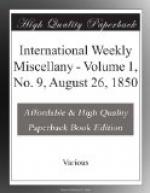* * * * *
Lessing’s new picture.—A letter from Duesseldorf under date of 9th July, in the Courier and Enquirer, says that Lessing’s great painting, “The Martyrdom of Huss,” Sad just been finished and had been exhibited for the last few days at the Academy of Fine Arts, where it was visited by thousands. When it became known that orders for its immediate shipment had arrived from New York, the desire to obtain a last view of this truly great work became so intense that it was found necessary to put the Police in requisition to keep back the throng, and the gates of the Academy had to be closed. It causes general regret that it is to be sent out of the country. The Cologne Gazette calls this picture the most sublime production of the great artist, and expresses the conviction that a speedy fortune might be realized by its exhibition in Europe.
* * * * *
Mr. George Flagg has just completed a portrait of Mrs. E. Oakes Smith, which will be ranked among the first productions of his pencil. We know of scarce a picture as beautiful or a portrait as truthful. It is to be engraved, we believe, by Cheney.
* * * * *
Mlle. Rachel.—The wonderful accuracy of the death-scene in “Adrienne Lecouvreur” has been the object of universal praise in London, not merely from the thrilled and thralled public, but from men of art and science. A physician, it is said, was complimenting Mademoiselle on her amazing truth to the symptoms of mortal agony: “You must have studied death closely,” said he. “Yes, I have,” was the quiet reply; “my maid’s. I went up to her—I stayed with her—she recommended her mother to me!—I was studying my part.” This is probably merely one of those cynical stories with which the sharp people of Paris love to environ and encircle every one who stands a dangerous chance of becoming too popular. But smaller artists than Mademoiselle Rachel have sometimes had recourse to curious expedients to give their dramatic personations a show at reality. The French prima donna, who not very long ago appeared in M. Clapisson’s poor opera, “Jeanne la Folle,” is said to have shut herself up in the Salpetriere, by way of studying her part, and to have been rewarded for her zealous curiosity by receiving a basin of scalding soup dashed in her face by one of the poor miserable objects of her examination.




